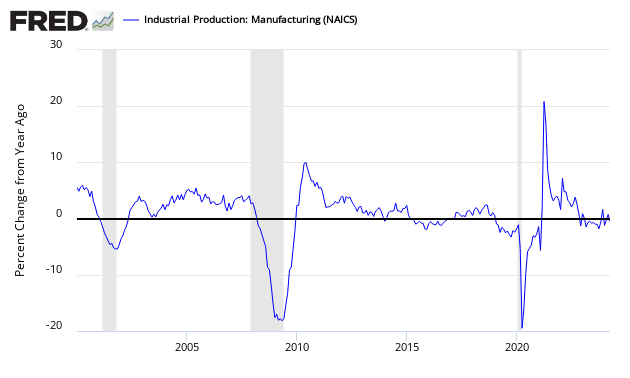February 2014 Empire State Survey Under Expectations, Internals Bad
The Empire State Manufacturing Survey degraded by remains in expansion territory in February 2014. Key internals are in contraction territory.
- Expectations were for a reading between 5.0 and 18.5 (consensus 8.5) versus the 4.5 reported. Any value above zero shows expansion for the New York area manufacturers.
- New orders sub-index of the Empire State Manufacturing Survey degraded significantly and now is marginally in contraction territory, whilst unfilled orders improved but remains in contraction.
- This noisy index has moved from 10.0 (February 2013) , 9.2 (March), 3.1 (April), -1.4 (May), 7.8 (June), 9.5 (July), 8.2 (August), 6.3 (September), 1.5 (October), -2.2 (November), +1.0 (December), +12.5 (January 2014) – and now +4.5.
As this index is very noisy, it is hard to understand what these massive moves up or down mean – however this regional manufacturing survey is normally one of the most pessimistic.
Econintersect reminds you that this is a survey (a quantification of opinion). Please see caveats at the end of this post. However, sometimes it is better not to look to deeply into the details of a noisy survey as just the overview is all you need to know.
From the report:
The February 2014 Empire State Manufacturing Survey indicates that business conditions improved marginally for New York manufacturers. The general business conditions index fell eight points, but remained positive at 4.5. The new orders index fell to about zero, indicating that orders were flat, and the shipments index declined thirteen points to 2.1. The unfilled orders index remained negative at -6.3. The prices paid index fell twelve points to 25.0, pointing to a slowing pace of input price increases, while the prices received index climbed two points to 15.0, suggesting a faster pace of selling price increases. Employment indexes were little changed, indicating a modest increase in employment levels and slightly longer workweeks. Indexes for the six-month outlook continued to convey fairly robust optimism about future conditions, even as the capital spending index fell ten points to 2.5, a multiyear low.
/images/z empire1.PNG
The above graphic shows that when the index is in negative territory that is not a signal of a recession: of 5 times in negative territory only one occurred with a recession. Conversely, a positive number is likely to be indicating economic expansion. However, when it does make a correct negative prediction it can be timely. This index was only two months late in going negative after what was eventually determined to be the start of the 2007 recession.
This survey has a lot extra bells and whistles which take attention away from the core questions: (1) are orders and (2) are unfilled orders (backlog) improving? Econintersectemphasizes these two survey points.
Respondents believe the level of unfilled orders (backlog) is trending up (looking at a 3 month rolling average; it has been negative since 2011. Unfilled order contraction can be a signal for a recession.
Holding this and other surveys Econintersect follows accountable for their predictions, the following graph compares the hard data from Industrial Products manufacturing subindex (long dark blue bar) and US Census manufacturing shipments (long pink bar) to the Empire State Survey (short darker green bar).
Comparing Surveys to Hard Data



/images/z survey1.png
In the above graphic, hard data is the long bars, and surveys are the short bars. The arrows on the left side are the key to growth or contraction.
Summary of all Federal Reserve Districts Manufacturing:
Richmond Fed (hyperlink to reports):
/images/z richmond_man.PNG
Kansas Fed (hyperlink to reports):
/images/z kansas_man.PNG
Dallas Fed (hyperlink to reports):
/images/z dallas_man.PNG
Philly Fed (hyperlink to reports):
/images/z philly fed1.PNG
New York Fed (hyperlink to reports):
/images/z empire1.PNG
Federal Reserve Industrial Production – Actual Data (hyperlink to report)

Caveats on the use of Empire State Manufacturing Survey:
This is a survey, a quantification of opinion – not facts and data. Surveys lead hard data by weeks to months, and can provide early insight into changing conditions. Econintersect finds they do not necessarily end up being consistent compared to hard economic data that comes later, and can miss economic turning points.
According to Bloomberg:
The Empire State Manufacturing Survey is a monthly survey of manufacturers in New York State conducted by the Federal Reserve Bank of New York. Participants from across the state in a variety of industries respond to a questionnaire and report the change in a variety of indicators from the previous month. Respondents also state the likely direction of these same indicators six months ahead. April 2002 is the first report, although survey data date back to July 2001. Each month, new data will be released and the previous month’s data will be revised slightly. Once per year, all data will undergo a benchmark revision.
This Empire State Survey is very noisy – and has shown recessionary conditions throughout the second half of 2011 – and no recession resulted. Overall, since the end of the 2007 recession – this index has indicated two false recession warnings.
No survey is accurate in projecting employment – and the Empire State Manufacturing Survey is no exception. Although there are some general correlation in trends, month-to-month movements have not correlated with the BLS Service Sector Employment data.
Over time, there is a general correlation with real manufacturing data – but month-to-month conflicts are frequent.
None.
Comments
 No Thumbs up yet!
No Thumbs up yet!









